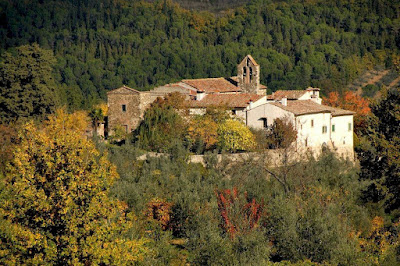The Italian word "pieve" means "parish church" in English, and the pievi of Chianti are in many ways a similar phenomenon to the ubiquitous Norman churches of England. They were built in large numbers during the period of rapid population growth that took place in Tuscany at the end of the Dark Age (the Early Mediaeval period), from roughly the year 950 onward, and they are dotted, often in ruins, all over the region.
Pieve di San Cresci - the parish church
Today, I want to talk about the Pieve di San Cresci which is thought to be one of the oldest pievi in Chianti. The nearby Pieve di San Pietro a Sillano might be older. The latter is mentioned in scrolls dating from the year 884 held at the nearby Abbey of Passignano. The Pieve di San Cresci is referred to in a document dated 963 which is held in the same library. A stone, carved in Longobard style, was found embedded in the wall of the nave during restoration, and this suggests that the Pieve di San Cresci was built on the site of a Longobard villa, perhaps incorporating part of the original structure.
The Pieve di San Cresci
The Pieve di San Cresci is located across the valley of the Becherale torrent from the fortified village of Montefioralle, about 2 km from Greve in Chianti, in the middle of the Chianti Classico wine zone. In fact, although Montefioralle houses the ancient church S. Stefano, rebuilt in the 17 C and 18 C, the Pieve of San Cresci is the original parish church of Montefioralle. The church is well worth a visit and can be reached easily by car or on foot from Greve along the road that passes by Villa Zano.
The interior of the church was completely rebuilt in Baroque style. However, part of the facade belongs to the original Romanesque church. The very photogenic lower part consists of two mullioned windows and is decorated with a dichromic motif in the archivolts.
Pieve di San Cresci - the winery
It's very common in Tuscany and especially in Chianti to see secular structures built onto churches (and also onto former military structures such as watch towers). The Pieve of San Cresci is no exception. The home of the Ballini family, wine makers here for at least six generations, is built onto the Pieve di San Cresci, and their winery, formerly Podere San Cresci but now named after the church, occupies cellars that were once a part of the church.
Listen to me, my dear intelligent and discerning readers! The red wines of Pieve di San Cresci winery are outstanding, even in a wine zone famous for its excellent wines. If you will be in the area of Greve in Chianti, I strongly recommend that you phone Pieve di San Cresci winery and make an appointment to taste their wines and maybe even pay a visit to the wine cellars. You won't regret it! They make a range of red wines,including of course Chianti Classico, Chianti Classico Riserva and Chianti Classico Gran Selezione (the new top-level denomination for Chianti wines), plus some very good Indicazione Geografica Tipica wines which have this designation because of their original grape composition, not because they are lesser wines.
Contact details and directionss for Pieve di San Cresci winery
More about Greve in Chianti.
|
Author: Anna Maria Baldini




